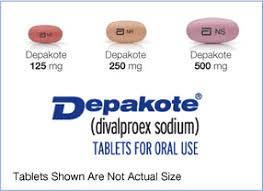What is Depakote ?
Embark on an exquisite exploration of Depakote (Divalproex Sodium), delving into its intricate chemical characteristics, comprehensive pharmacological insights, applications, and essential considerations.
Overview
Chemical Designation: Divalproex Sodium is a meticulously crafted coordination compound, harmoniously combining valproic acid with its sodium counterpart in a precise 1:1 molar ratio.
Molecular Composition:
C8H15NaO4
Pharmaceutical Category: Anticonvulsant and mood stabilizer.
Pharmacological Classification
Anticonvulsant/Anti-epileptic: Effectively diminishes seizure occurrences.
Mood Stabilizer: Regulates manic episodes associated with bipolar disorder.
Migraine Prophylaxis Agent: Aims to avert migraines without addressing acute episodes.
Approved Uses
Seizures
Administered independently or alongside other therapies to control:
Complex Partial Seizures: Focal seizures that disrupt consciousness.
Simple and Complex Absence Seizures: Non-motor seizures characterized by episodes of staring.
Generalized Seizures: Tonic-clonic seizures as part of combination therapy.
Bipolar Disorder
Addresses manic episodes, which are marked by heightened mood, increased activity, racing thoughts, and impulsive actions.
Migraine Prevention
Lowers the incidence of migraines, though it does not alleviate acute migraine episodes.
Dosage and Administration
Formulations
Immediate-Release Tablets: Designed for swift action.
Extended-Release Tablets (ER): Provide sustained therapeutic effects over a 24-hour period.
Sprinkle Capsules: Versatile in administration, either swallowed whole or sprinkled onto soft foods.
Typical Dosage Guidelines
Seizures:
Initial: 10–15 mg/kg/day
Maintenance: Up to 60 mg/kg/day, tailored to individual tolerance and effectiveness.
Bipolar Disorder:
Initial: 750 mg/day, divided into multiple doses.
Target range: Serum concentrations maintained between 50–125 mcg/mL.
Migraine Prophylaxis:
Initial: 250 mg administered twice daily.
Maximum: 1000 mg/day.
Serum Monitoring
Therapeutic Range: 50–125 mcg/mL for effective seizure and bipolar disorder management.
Toxic Levels: Exceeding 150 mcg/mL may result in severe complications.
Mechanism of Action
Augments GABA (Gamma-Aminobutyric Acid):
Elevates the brain’s primary inhibitory neurotransmitter, soothing hyperactive neurons.
Stabilizes Neuronal Membranes:
Mitigates excessive neuronal firing by obstructing voltage-gated sodium and calcium channels.
Modulates Excitatory Neurotransmitters:
Lowers excitatory signals, thereby diminishing seizure occurrences and mood fluctuations.
Side Effects
Common Side Effects
Neurological:
Somnolence
Vertigo
Tremors
Muscle weakness
Visual disturbances
Gastrointestinal:
Nausea, vomiting, abdominal discomfort
Diarrhea or constipation
Other:
Alopecia
Weight gain
Decreased appetite
Serious Side Effects
Hepatic Toxicity:
May result in liver damage, particularly in children under 2 years.
Symptoms: Jaundice, dark urine, fatigue.
Monitoring: Liver function assessments (ALT, AST, bilirubin) prior to treatment and during the initial six months.
Pancreatitis:
A rare yet potentially life-threatening inflammation of the pancreas.
Symptoms: Intense abdominal pain, nausea, vomiting.
Hyperammonemia:
Elevated ammonia levels leading to confusion, lethargy, or encephalopathy.
Regular blood ammonia monitoring may be necessary.
Thrombocytopenia:
Reduced platelet count, resulting in excessive bruising or bleeding.
Teratogenicity:
Can induce neural tube defects (such as spina bifida), developmental delays, and facial anomalies in the fetus.
Pregnancy Category: X for migraine and D for seizures/bipolar disorder.
Hypothermia:
Occasionally results in lowered body temperature.
Contraindications
Absolute Contraindications:
Documented hypersensitivity to valproic acid.
Severe hepatic impairment or urea cycle disorders.
Pregnant individuals (unless no alternatives are available).
Relative Contraindications:
Pancreatic disorders.
Mitochondrial conditions (e.g., Alpers-Huttenlocher syndrome).
Drug Interactions
Heightened Risk of Adverse Effects:
CNS Depressants (such as alcohol and sedatives): Heightens drowsiness.
Anticoagulants (like warfarin): Elevates the risk of bleeding through platelet inhibition.
Other Anticonvulsants:
Phenytoin and Carbamazepine: Modifies the blood concentrations of both medications.
Lamotrigine: Raises the likelihood of rash due to increased levels of lamotrigine.
Diminished Effectiveness:
Carbapenem Antibiotics (for instance, meropenem): Lowers the levels of Depakote.
Rifampin: Reduces its serum concentration.
Monitoring and Laboratory Assessments
Liver Function: Regular testing of ALT, AST, and bilirubin during the initial six months.
Serum Ammonia: Monitor if symptoms of lethargy or confusion manifest.
Platelet Counts: To evaluate for thrombocytopenia.
Serum Drug Levels: To confirm therapeutic levels (50–125 mcg/mL).
Special Considerations
Pregnancy and Teratogenic Risks
Depakote carries a significant risk of teratogenic effects. Women of childbearing age should:
Utilize effective contraception.
Explore alternative medications when feasible.
Participate in pregnancy registries if exposed.
Pediatric Use
While effective for managing seizures in children, it necessitates heightened caution due to potential liver toxicity.
Elderly Use
Administer with care due to increased vulnerability to sedation, confusion, and tremors.
Abrupt Discontinuation
Refrain from sudden cessation to avert seizure exacerbation or withdrawal symptoms.
Overdose Management
Symptoms:
Severe lethargy, unresponsiveness, hypotension, respiratory distress, and lactic acidosis.
Treatment:
Gastric Lavage: Administered if the ingestion occurred recently.
Activated Charcoal: Utilized to diminish drug absorption.
Supportive Measures:
Intravenous fluids to ensure blood pressure stability.
Mechanical ventilation may be necessary if respiratory function is compromised.
Hemodialysis: Employed to extract the drug from the bloodstream in critical situations.

Brand Names and Generic Availability
Brands: Depakote, Depakote ER, Depakote Sprinkle.
Generics: Commonly accessible as Divalproex Sodium or Valproic Acid in a variety of formulations.
Summary:
Renowned for its efficacy, Depakote serves as a sophisticated treatment option for epilepsy, bipolar disorder, and migraines. However, the intricacies of its use demand vigilant supervision due to associated risks like hepatic damage, pancreatitis, and teratogenicity. It is essential to consult with a healthcare expert to establish individualized treatment strategies and monitoring plans.



